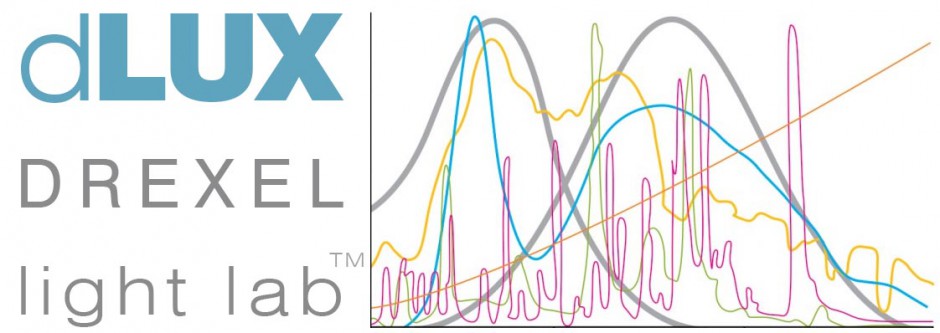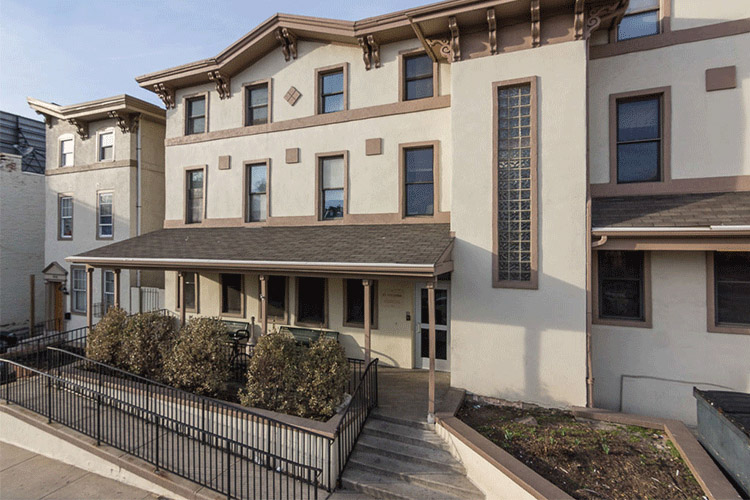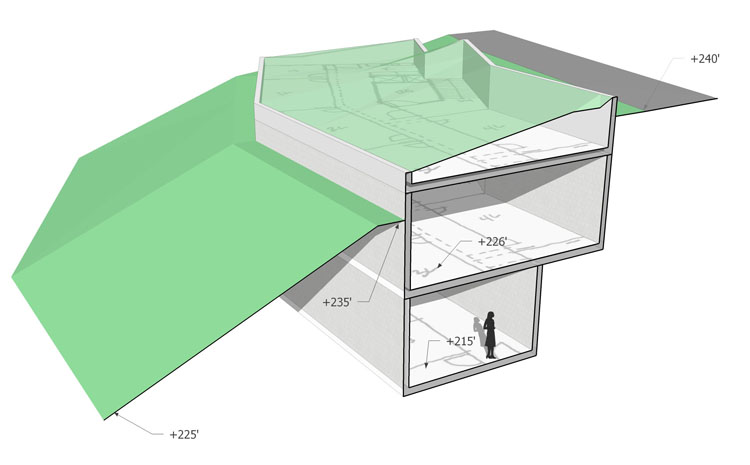dLUX is part of Drexel University’s Urban Design & Health team, one of 11 inaugural members of the American Institute of Architect’s (AIA) Design and Health Research Consortium.
dLUX light lab partners with Project H.O.M.E. at their St Columba safe haven residence for men
One of the projects affiliated with the Urban Design & Health team is for the St. Columba safe haven residence for men. dLUX has partnered with Project H.O.M.E. to install its solar-day mimicking LED lighting system in their 25 bed dormitory. At St. Columba residents are offered service coordination, personal recovery services, health care, education, social enterprise and employment opportunities. Residents are encouraged to participate in recovery-oriented activities that lead to personal growth, well-being and self-sufficiency with a focus on moving to permanent housing.
Research has shown that LED Solid State Lighting is more energy-efficient and longer lasting with lower lifecycle costs than other light sources and that natural daylight controls the body’s circadian rhythms and affects overall wellbeing. dLUX is installing a fully programmed, automatic integrated LED lighting system that simulates the optimal color and intensity of natural daylight throughout the day to regulate the men’s circadian rhythms. In lieu of complete darkness at night, lighting will dim to the red spectrum to provide night lighting as needed. The goal is to prevent disrupted sleep patterns and the negative behaviors associated with sleep deprivation and to promote the residents’ overall health and wellbeing. The overall goal of the redesigned interior environment is to support the residents’ transitioning to become members of the broader society. The dLUX team includes Dr. Donald McEachron, Dr. Eugenia Victoria Ellis, AIA and Greg Yeutter.
The Austrian Marshall Plan Scholarship Program funds dLUX student researcher to the University of Applied Sciences in Dornbirn, Austria
The use of LED lighting is rapidly increasing because of its low energy use and its ability to easily change color. dLUX has been developing LED lighting systems that mimic the diurnal color-changing conditions of natural daylight to promote circadian rhythm, reduce sleep disturbances and improve health outcomes of various vulnerable populations such as children with autism, older adults with dementia and adult homeless men. dLUX research has shown that both the variable lighting intensity and color temperature of diurnal natural sunlight, as well as complete darkness, are crucial to achieve bodily temporal order and promote positive health outcomes. This can most easily be simulated with LED lighting technology. Recent studies, however, have shown that the flicker of electric light can have detrimental effects.
Mark Cardish of the dLUX light lab will spend six months at the University of Applied Sciences in Dornbirn, Austria where he will create or identify the most effective practice to reduce flicker in alternating current based LED luminaires. His research will be funded through the Austrian Marshall Plan Scholarship Program, an academic exchange program to finance scholarships and fellowships for academic exchange between Austria and the U.S. with a special focus on universities of applied sciences and technical universities.
dLUX light lab creates lighting biome for Madagascar lemurs at the San Diego Zoo
For the past several years dLUX has been developing LED lighting systems to address the dual sustainability issues of energy efficiency and health/wellbeing of building occupants. Research has shown LED Solid State Lighting to be more energy-efficient and longer lasting with lower lifecycle costs than other light sources and that natural daylight controls the body’s circadian rhythms and affects overall wellbeing.
dLUX is partnering with RT Lonsdale of the San Diego architecture firm The Miller Hull Partnership to develop the Lemur building for “Africa Rocks”, the largest single-phase construction project that the San Diego Zoo has ever undertaken. dLUX expertise in chronobiology and innovative LED controls systems technology will develop a lighting biome to simulate the lemur’s natural Madagascar habitat. Lemurs that will be housed there include: Blue-eyed Black, Red Ruffed, Sifaka Collared, and Ring-tailed. The dLUX team includes Dr. Donald McEachron, Dr. Eugenia Victoria Ellis, AIA and Greg Yeutter.
HOMElight
see HOMElight run
dLUX HOMElight is a controller to interface with newly-available color-changing LED light bulbs for the consumer market. The controller enables sun-mimicking light patterns in the home by simply replacing standard light bulbs. The product is aimed at individuals with seasonal affective disorder as well as the growing number of personal health hobbyists. It is also part of a series of innovations that enable elderly users to live independently at home for as long as possible. The introduction of this controller will enable the dLUX lighting lab to study the effects of sunlight-mimicking technology on a broader spectrum of users and make further refinements to the fixture and controller designs.
DARKlight
dLUX DARKLight is a low-energy modular, luminous surface lighting system that rethinks illumination by considering luminous surfaces in lieu of traditional luminaires to provide quality commercial and residential low-level lighting. DARKlight is based on Organic Light Emitting Diode (OLED) technology, utilizes environmentally friendly materials and generates minimal heat without light pollution. Each panel is one pixel of light regardless of size; luminance is conducted panel to panel through the panel itself requiring one source of power with the potential to form a wall of light. While modular, this surface lighting system dissolves the grid to provide a continuous luminous wall surface with acoustic properties. DARKlight transforms lighting from the traditional light fixture illuminated by a light source (lamp, CFL, LED, etc.) to an integrated luminous surface system. Unlike traditional lighting systems, DARKlight uses little energy and provides illumination without heat generation resulting in an overall reduction in cooling loads, promoting building efficiency.
SOLARlight
see SOLARlight run
dLUX SOLARlight evenly distributes natural daylighting supplied by a commercially available light harvester to the interior of a building where limited access to exterior openings is available. The illumination level provided SOLARlight remains constant regardless of exterior weather conditions, the color temperature of the light emitted will match natural daylight and change throughout the day to match diurnal conditions, the lighting level can be adjusted manually and the light source will be able to be turned off when no illumination is desired. Through an optically calibrated lens, SOLARlight also equilibrates the lighting quality of the two disparate light sources so that the light emitted from the solar source and the LED sources behave similarly. SOLARlight provides indirect light without glare or veiling effects.
DUOlight
see DUOlight run – see DUOlight made
dLUX DUOlight is a 2’ x 2’ recessed LED luminaire prototype for retrofit commercial installation. Using AUTOlight technology to auto-tune natural daylight, DUOlight provides 24-hour diffuse light and concentrated noontime peak lighting. DUOlight is a fully programmed, automatic integrated LED luminaire that simulates the optimal color and intensity of natural daylight throughout the day to regulate the body’s circadian system. In lieu of complete darkness at night, DUOlight dims to the red spectrum to provide night lighting as needed.
AUTOlight
dLUX AUTOlight addresses the dual sustainability issues of energy efficiency and health/wellbeing of building occupants. Research has shown LED Solid State Lighting to be more energy-efficient and longer lasting with lower lifecycle costs than other light sources and that natural daylight controls the body’s circadian rhythms and affects overall wellbeing. AUTOlight is a fully programmed, automatic integrated LED lamp that simulates the optimal color and intensity of natural daylight throughout the day to regulate the body’s circadian system. AUTOlight will be set automatically according to the world clock in Denver, CO; if there is a power interruption, it will reset itself according to both time zone and date to auto-tune to natural daylight levels. In lieu of complete darkness at night, AUTOlight dims to the red spectrum to provide night lighting as needed. AUTOlight can be turned off as desired and when turned back on will auto-tune to natural lighting levels for optimal circadian health.




